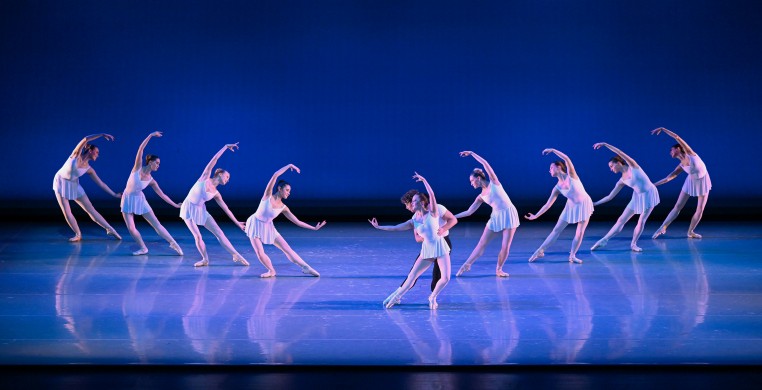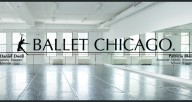Ballet Chicago’s new season of “Balanchine and Beyond” brought an old favorite, a genre-changing Balanchine classic, and two exciting new works to Chicago’s Harris Theater for two performances last Saturday, May 13.
As a “studio company,” Ballet Chicago is technically a semi-professional operation, but there is nothing “semi” about the polished matinee performance of artistic director Daniel Duell’s revised Hansel and Gretel (1993), resident choreographer Ted Seymour’s two world premieres, 4 Hands for 18 Feet, and Tone Poem, and George Balanchine’s masterpiece, Concerto Barocco (1941).
It’s interesting to note that Ballet Chicago’s roster features pre- and semi-professional dancers of the same ages as Balanchine’s original cast for this genre-bending ballet, including a 14-year-old Tanaquil LeCleq and 17-year-old Diana Adams, both of whom went on to become principal dancers in Balanchine’s New York City Ballet, founded with Lincoln Kirstein in 1948. Guest artists with bona fide professional credits contribute to distinguishing Ballet Chicago as a unique artistic enterprise.
But first, let’s revisit Duell’s Hansel and Gretel. Set to Kimberly Schmidt’s lush orchestral arrangement of Humperdink’s original 1893 opera score, Duell’s gentle storytelling softens the grimness of the original Brothers Grimm fairytale, portraying the parents as struggling to put food on the table in a time of famine and poverty across Europe. They have enlisted their children, Hansel and Gretel, impeccably danced by Tyler Bianchi and Emma Wittig, to make brooms to sell in the village marketplace. The children, playful as kids are known to be, are soon distracted and delight in dancing together. Their parents catch them having too much fun and drive them off with harsh scolding, from which the children flee to the forest and promptly get lost.
 A scene from Daniel Duell’s "Hansel and Gretel"; Photo by Ron McKinney Photography
A scene from Daniel Duell’s "Hansel and Gretel"; Photo by Ron McKinney Photography
Veteran lighting designer Margaret Nelson contributes as much to the storytelling as does the choreography and dancing. Projected scenes seamlessly, and quickly, transport us from Hansel and Gretel’s cottage to the forest to the Witch’s candy house and home again without interrupting flow, creating the illusion of osmosis to transport us from one scene to the next.
In the forest, a brave Hansel valiantly vanquishes a ferocious wolf (Quinn Rutman). A battalion of Bunnies, the youngest students in Ballet Chicago’s training program, greets them, followed by a host of other cuddly forest friends, in graduating levels of technical advancement, from Deer with antlers to the ethereal Forest Fairies, who welcome the two children with dances suited to their level of training but also to the dramatic and artistic requirements of the storytelling.
A starving Hansel and Gretel awaken to find the perfect kid’s breakfast—a magnificent house made entirely of gingerbread and candy. No sooner do they begin to nibble, out comes the wicked Witch (Mimi McKelly) with her crooked fingers, flexed feet and diabolical magic broom. Before we know it, Hansel is caged, being fattened for gingerbread batter, while a military parade of automaton gingerbread children march to the Witch’s command.
Meanwhile, Gretel becomes the Witch’s maid, feigning obedience but clandestinely plotting with Hansel to escape. This all happens with clever trickery, the children overcoming the wicked adult. Duell doesn’t miss an opportunity for humor in the witch’s demise, with the children helping the witch to trip on her own broom and catapulting herself into her own boiling cauldron, her hands and feet sticking up at odd angles. Just desserts!
The children reunite with their parents in a denouement that has everyone hugging and, in grand ballet tradition, Hansel and Gretel relive their harrowing adventure via pantomime for their parents. The story ends on a hopeful note, “happily ever after.”
Unifying the multi-age cast of some ninety dancers is one of Duell’s most impressive magic tricks. But of course, it’s no trick that his commitment to perpetuating Balanchine’s unique training curriculum and choreographic vision, along with his wife, associate artistic director Patricia Blair, has turned out generations of dancers who combine both technical virtuosity and artistic depth. From forest bunnies to gingerbread children, forest fairies to guardian angels, the detailed attention to port de bras and movement flow far transcends mere execution of “steps.” Make no mistake, “Hansel and Gretel” is an artistic achievement of the highest professional standards.
The first of Ted Seymour’s two world premieres, 4 Hands for 18 Feet, is a lyric suite for three principal couples, and four additional dancers, set to composer Cecille Chaminade's 6 Pieces Romantique. The music, waltzes, polkas, polonaises, and a tarantula, are performed live on stage by the duo pianists, Elena Doubovitskaya and Svetlana Belsky. The episodic mix of dances flows from one to the next, two women lifting a man, two men partnering a woman, liquid exchange of partners and spatial formations, transmits a sunny mood of pure dance with the sure hand of a choreographer who knows how to manipulate spatial design. The always changing configurations of soloists, couples, trios and full-group movement provides a constant element of surprise. It also manages to provide a showcase for the dancers’ technical and expressive strengths, and for Seymour’s ever-evolving maturity as a choreographer.
 The ensemble performs in Ted Seymour’s "Tone Poem"; Photo by Ron McKinney Photography
The ensemble performs in Ted Seymour’s "Tone Poem"; Photo by Ron McKinney Photography
In stark contrast, Seymour’s Tone Poem, set to a score by Zoe Keating and Ludovico Einaudi, excites and challenges across a spectrum of non-traditional spatial design and movement vocabulary that draws from theater, modern dance, contemporary ballet, and the confluence of sound and impulse, unlike anything I have ever seen in Seymour’s work before.
Sharp musical “pings,” new-age serial music, and silence mirror sudden, angular gestures, mechanical reflections of the creeping replacement of human beings by machines. Tone Poem, with a full company cast, plays with seemingly vast numbers of dancers onstage, mass movement and poignant solo moments, an ever-shifting mix of unison and syncopated moments, with key moves recurring and painting a portrait of an agitated world.
The program finale of Balanchine’s Concerto Barocco brought it all to a stunning conclusion, with the great 20th-century master’s hallmark choreographic visualization of Bach’s Brandenburg Concerto.
With this piece, Balanchine launched an artistic vision that transformed traditional classical ballet into an art form of the people, reflecting a contemporary world of abstract art, human emotion and psychological conflict. Ballet Chicago is one of the few companies in the world perpetuating Balanchine’s legacy through his influence on the creativity of its artists and through the performance of Balanchine repertoire. Bravo!


